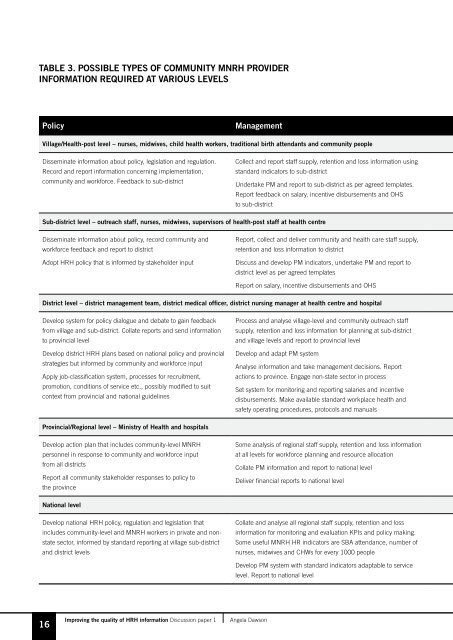improving the quality of hrh information - HRH Knowledge Hub ...
improving the quality of hrh information - HRH Knowledge Hub ...
improving the quality of hrh information - HRH Knowledge Hub ...
You also want an ePaper? Increase the reach of your titles
YUMPU automatically turns print PDFs into web optimized ePapers that Google loves.
Table 3. Possible types <strong>of</strong> community MNRH provider<br />
<strong>information</strong> required at various levels<br />
Policy<br />
Management<br />
Village/Health-post level – nurses, midwives, child health workers, traditional birth attendants and community people<br />
Disseminate <strong>information</strong> about policy, legislation and regulation.<br />
Record and report <strong>information</strong> concerning implementation,<br />
community and workforce. Feedback to sub-district<br />
Collect and report staff supply, retention and loss <strong>information</strong> using<br />
standard indicators to sub-district<br />
Undertake PM and report to sub-district as per agreed templates.<br />
Report feedback on salary, incentive disbursements and OHS<br />
to sub-district<br />
Sub-district level – outreach staff, nurses, midwives, supervisors <strong>of</strong> health-post staff at health centre<br />
Disseminate <strong>information</strong> about policy, record community and<br />
workforce feedback and report to district<br />
Adopt <strong>HRH</strong> policy that is informed by stakeholder input<br />
Report, collect and deliver community and health care staff supply,<br />
retention and loss <strong>information</strong> to district<br />
Discuss and develop PM indicators, undertake PM and report to<br />
district level as per agreed templates<br />
Report on salary, incentive disbursements and OHS<br />
District level – district management team, district medical <strong>of</strong>ficer, district nursing manager at health centre and hospital<br />
Develop system for policy dialogue and debate to gain feedback<br />
from village and sub-district. Collate reports and send <strong>information</strong><br />
to provincial level<br />
Develop district <strong>HRH</strong> plans based on national policy and provincial<br />
strategies but informed by community and workforce input<br />
Apply job-classification system, processes for recruitment,<br />
promotion, conditions <strong>of</strong> service etc., possibly modified to suit<br />
context from provincial and national guidelines<br />
Process and analyse village-level and community outreach staff<br />
supply, retention and loss <strong>information</strong> for planning at sub-district<br />
and village levels and report to provincial level<br />
Develop and adapt PM system<br />
Analyse <strong>information</strong> and take management decisions. Report<br />
actions to province. Engage non-state sector in process<br />
Set system for monitoring and reporting salaries and incentive<br />
disbursements. Make available standard workplace health and<br />
safety operating procedures, protocols and manuals<br />
Provincial/Regional level – Ministry <strong>of</strong> Health and hospitals<br />
Develop action plan that includes community-level MNRH<br />
personnel in response to community and workforce input<br />
from all districts<br />
Report all community stakeholder responses to policy to<br />
<strong>the</strong> province<br />
Some analysis <strong>of</strong> regional staff supply, retention and loss <strong>information</strong><br />
at all levels for workforce planning and resource allocation<br />
Collate PM <strong>information</strong> and report to national level<br />
Deliver financial reports to national level<br />
National level<br />
Develop national <strong>HRH</strong> policy, regulation and legislation that<br />
includes community-level and MNRH workers in private and nonstate<br />
sector, informed by standard reporting at village sub-district<br />
and district levels<br />
Collate and analyse all regional staff supply, retention and loss<br />
<strong>information</strong> for monitoring and evaluation KPIs and policy making.<br />
Some useful MNRH HR indicators are SBA attendance, number <strong>of</strong><br />
nurses, midwives and CHWs for every 1000 people<br />
Develop PM system with standard indicators adaptable to service<br />
level. Report to national level<br />
16<br />
Improving <strong>the</strong> <strong>quality</strong> <strong>of</strong> <strong>HRH</strong> <strong>information</strong> Discussion paper 1<br />
Angela Dawson

















